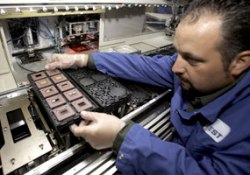Dec 17 2010
The interesting aspect about the working of sensors has been highlighted at the Hartford-based Connecticut Science Museum. It has been found that the sensors will be a significant component in the future for lowering the emission rate, with advancements in innovative intelligent network technologies.
 Current Sensors at IBM
Current Sensors at IBM
The miniature sensors developed by IBM, Hewlett-Packard and Intel play a major part in the utilization and production of energy. For example, the sensors made by HP makes an autonomous appliance such as a refrigerator to turn off for some period, permitting the company to stabilize real time power requirements in a low level, without affecting the foods preserved in it.
Sensors are the foremost constituent of intelligent meters in the home, linking utilities and home, furnishing live data on the expenses of power, where it is going and facilitating the user to carry out small levels of regulations from any location. IBM has implemented this technology to their Burlington-oriented semiconductor plant by integrating 60,000 sensors for balancing its power, heating, water, and lighting applications. Thus the current and fuel consumption in the plant has decreased by one fifth by its full time usage.
The sensors can also identify the pollutants and hazardous materials in water and can be functioned without batteries in the future. According to the company spokespeople, with the advancements in technology, the sensors will address the “Internet of Things,” and will create a new period of miniature devices, revolutionizing the market growth.